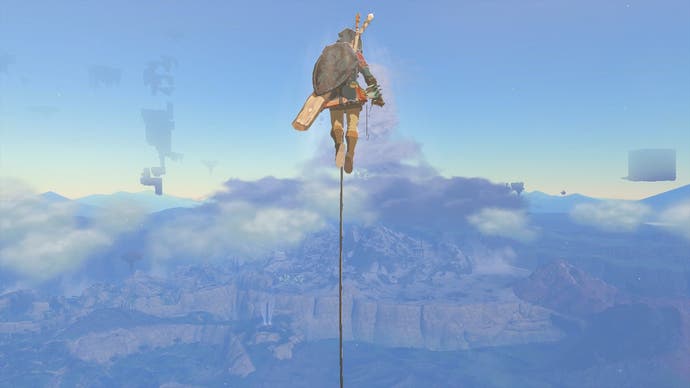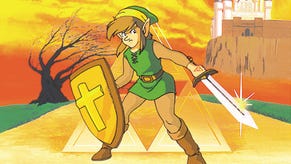Tears of the Kingdom shows that without change, accessibility in Nintendo games will remain accidental
Link to the past.
The Legend of Zelda: Tears of the Kingdom is an evolution. From the world of 2017's Breath of the Wild, Nintendo has created something richer and more malleable through a grander story, an expanded map, and the ability to build countless contraptions to torture innocent Koroks. Fifty hours in, I'm yet to even start any story-related adventure, and I'm more interested in dressing Link in cute outfits. Does that make the game good or bad? I have no idea!
As with so many Nintendo games, however, it's an evolution that comes with a price to pay for many players. Tears of the Kingdom may be a glow-up for Switch-era Hyrule, but fundamentally little has changed in the six years between titles. Which is to say that the game remains, somehow, both accessible and inaccessible at the same time.
This is only made more clear by the accessibility advancements the gaming industry has made between The Legend of Zelda releases. These are advancements that may have finally cracked the perceived apathy towards accessibility exhibited by Japanese studios, but that Nintendo continues to ignore.
It's disappointing, if not exactly unexpected, to see players struggle with the biggest game of 2023. And one that, if Elden Ring's enduring popularity is anything to go by, will be part of online conversation for years.
That Tears of the Kingdom wouldn't prioritise accessibility in its development has been evident as early as 2019, when Jason Schreier asked series director, Eiji Aonuma, about the lack of button mapping in Breath of the Wild.
"If we freely let players do customizations on key assignments and such, I feel like we're letting go of our responsibility as a developer," Aonuma said. "We have something in mind for everybody when we play the game, so that's what we hope players experience and enjoy as well."
Pressed on the importance of remapping for disabled players, Aonuma's response was non-committal. "That's a very good point," he said. "That's something we'll keep in mind going forward."
Four years later, many are experiencing less Tears of the Kingdom and more just tears because we're pressing the wrong buttons because of the game's baffling control scheme.
That said, Tears of the Kingdom isn't without improvements. Mandatory motion controls are gone, though players still have no control over UI readability beyond making text boxes more opaque, and nothing to mitigate Tears of the Kingdom's silent speech and many inputs.

The game does include a chat log and recipe book, however, both of which are great additions for people with cognitive disabilities (though the cluttered layout of both suggests that wasn't the intent). But the game's habit of placing quest markers on quest givers rather than at the destination is a cognitive nightmare. Elsewhere, hiding combat prompts behind missable tutorials is one of the game's most baffling design decisions.
All of which paints a remarkably inaccessible picture in 2023, one made all the more ironic by a game that centres on a main character experiencing disability.
Rather than developing accessibility, Tears of the Kingdom continues a trend to which Nintendo has weirdly adhered for years. It's a trend in which accessibility in its games feels almost accidental.
We can't say for sure what considerations went into the tangential accessibility Nintendo employs. We can only surmise that there's no evidence disabled players are a focus for the company, while there's plenty of evidence in their games that we're not. Instead, features that feel designed for a different demographic or purpose just happen to end up helping us - sometimes.
For instance, Animal Crossing: New Horizons uses a robust set of sound cues in its fishing minigame. These are cues that make it easier and more fun for blind and visually impaired players. But sound design otherwise swings from accessible to inaccessible in this game, especially around character speech.
A more pertinent example may be the Bullet Time effect in Breath of the Wild and its sequel when using a bow in the air. It's necessary to make shooting while falling viable, but it also becomes vital for aiding many disabled players in general combat - including visually impaired players. This is something Tears of the Kingdom actually adds to with its homing arrows. But, again, with most speech unvoiced elsewhere, it's hard to see that those players were a consideration.

Even Nintendo's hardware is unintentionally accessible. The low-grade graphics on the Switch make for an easier visual experience for many, even though they're dictated by the console's hardware limitations. Meanwhile, the Switch's dedication to portability makes controllers lighter, and so easier for some with mobility and pain issues to hold.
You can see the pattern already. Nintendo consistently adds accessible features into its games that don't feel like accessibility features. They're not built with disabled players in mind, they just happen to help in specific contexts - and often in otherwise inaccessible games. This, despite a persistently stubborn attitude to accessibility, and despite Nintendo's litigious approach to preservation and homage.
It raises the question. If Nintendo repeatedly ignores inclusive design, why are so many of its games accidentally accessible? A clue can be found in March's Nintendo Direct, in which Eiji Aonuma showed off Tears of the Kingdom gameplay.
When demonstrating the new homing arrows function, Aonuma let slip an interesting admission. "My eyes can't track fast-moving objects as of late," he said. Sixty-year-old Aonuma's appraisal feels like an acknowledgement of the cognitive difficulties faced by older players.
Nintendo can make accessible games. Its developers do make accessible games. In fact, accessibility is baked into the company's fundamental understanding of game design. What Aonuma's admission shows, however, is that Nintendo considers accessibility for an age-driven market, rather than as part of an inclusive approach to design.
While Sony and Microsoft work to make gaming for everyone, Nintendo's focus is on creating games for a wide range of age demographics - the whole family, so to speak. This is obvious when you consider how Nintendo has positioned itself as the family-oriented developer. It's why its games are accessible to inexperienced and experienced gamers alike, but also why we see so much accidental accessibility in games that otherwise work against their disabled playerbase. It's why homing arrows in Tears of the Kingdom are great for blind and visually-impaired players, but there are little to no considerations of how they navigate the world and story otherwise.
Understand that none of this is to actively denigrate the accessibility found in Tears of the Kingdom and other Nintendo games, accidental or otherwise. Rather, it's to show that Nintendo understands the fundamentals of accessible game design. It gets that accessibility is about more than just settings - at a time when options are a focus for many - and clearly understands how to implement accessible features. It's to show that it would be so easy for Nintendo to shift to being more inclusive and in the process become an industry leader - if not the industry leader - in accessible design.
To do that, however, Nintendo would need to give players more control over their individual experience. The company would need to build on a strong baseline accessibility found in many Nintendo games, and supplement it with features and options that make playing Nintendo games more aware of individual players' needs. This is something it currently appears loath to do.
Which is what makes Nintendo so frustrating - what makes Tears of the Kingdom so frustrating. Finding ways to play or design decisions that make inaccessible games momentarily easier is great, it signals Nintendo's ability to create strong baseline accessibility almost without trying. But unless Nintendo shows a willingness to build on that and consider disabled players, to make games for everyone, its accessibility will never be more than an accident.









